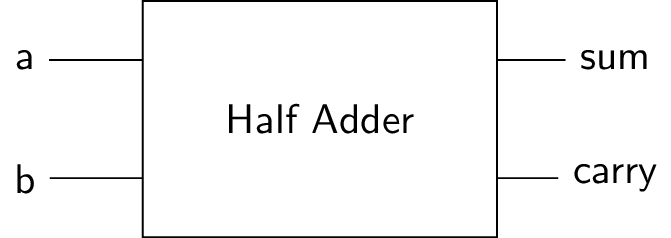Combinational Circuits I
(Usage hints for this presentation)
IT Systems, Summer Term 2025
Dr. Jens Lechtenbörger (License Information)
1. Introduction
1.1. Today’s Core Question
- How can we perform arithmetic and logic operations on integer
numbers, starting from Boolean logic?
- Based on Chapter 2 of (Nisan and Schocken 2005)
1.2. Learning Objectives
- Compute 2’s complement of a binary number and use it for addition and subtraction
- Build, test, and analyze combinational circuits
leading to the Hack ALU (Project 2)
- Half and full adder, Ripple-Carry Adder (
Add16) - Incrementer (
Inc16) ALU
- Half and full adder, Ripple-Carry Adder (
- Determine ALU operation based on control bits
1.3. Retrieval Practice
Prior knowledge
- How do you add two numbers with pen and paper, say 4242 + 6789?
- What is 101010 in decimal?
- What is a multi-bit chip?
Agenda
- Part 1
- Break for self-study
- Part 2
2. Addition
2.1. Pen-and-paper method
We add digits from right to left, possibly with “carry”
In decimal
4242 + 6789 Carry: 11110 ----- 11031In binary
10110111 + 11000101 Carry: 100000110 --------- 101111100
Note
- Rightmost (lowest) position with carry 0
- Only need to add 2 bits
- Other positions need to add 3 bits
Both sample results are 1 digit larger than the inputs
- Overflow in case of fixed digits/bits; incorrect result if discarded
- Rightmost (lowest) position with carry 0
2.2. Adding with fixed bits
- Binary addition of previous slide
- 10110111 + 11000101 = 101111100 (= 380)
- Suppose restriction to 8 bits
- Largest number is \(2^{8} - 1 = 255\)
- 8-bit-result (drop leading 1 and 0): 1111100 (= 124)
- Incorrect, overflow, bug
- Examples at Wikipedia
- Insight (recall Fail task)
- Restricting to \(n\) bits corresponds to
Modulo operation
- \(\mod 2^n\)
- \(n=8\): 10110111 + 11000101 = 1111100 mod 256
- Restricting to \(n\) bits corresponds to
Modulo operation
3. 2’s Complement
3.1. Definitions
Consider \(n\)-bit number \(k\)
\(k_c = 2^n - k\) is 2’s complement of \(k\) (and vice versa)
- Note: \(k + k_c = 2^n = 0 \mod 2^n\), i.e., complementary numbers add up to zero
- E.g., \(n=4\), \(2^4 = 16\): \(1\) and \(15\) are complements of each other; \(8\) is complement of itself
- If most significant bit of \(k\) is 0, interpret as (usual) positive number
If most significant bit is 1, interpret bit pattern as negative number: \(k = -k_c\)
- E.g., \(15 = (1111)_2\) and \(8 = (1000)_2\) are interpreted as negative numbers under 2’s complement: \((1111)_2 = -1\) and \((1000)_2 = -8\)
3.2. Example and Conversion
\(2^n\) signed numbers between \(-2^{n-1}\) and \(2^{n-1} - 1\)
- E.g., \(n=4\)
0 0000 1 0001 1111 -1 2 0010 1110 -2 3 0011 1101 -3 4 0100 1100 -4 5 0101 1011 -5 6 0110 1010 -6 7 0111 1001 -7 1000 -8- Note
- Positive numbers start with 0
- Usual binary number
- Negative numbers start with 1
- To convert a number
- Leave all trailing 0’s and first 1 intact, flip all remaining bits or
- Flip all bits and add 1
- Positive numbers start with 0
3.3. Addition with 2’s Complement
- We just add bit patterns, mod \(2^n\)
- No need to treat negative numbers specially
- Subtraction as addition with 2’s complement
Example
2-5 = 2 + (-5): 0010 + 1011 ---- 1101 = -3
- In Hack, overflows will be ignored
- Programming bug
4. Building an Adder Chip
- Sequence of chips
- Increasing complexity
HalfAdder: Adds two bits, produces two output bitsFullAdder: Adds three bits, produces two output bits- Ripple-Carry-Adder,
Add16: Adds two 16-bit numbers, produces 16-bit output
- Increasing complexity
4.1. Half Adder
| a | b | carry | sum |
|---|---|---|---|
| 0 | 0 | 0 | 0 |
| 0 | 1 | 0 | 1 |
| 1 | 0 | 0 | 1 |
| 1 | 1 | 1 | 0 |
- Several implementations possible
- DNF with Not, And, Or
- Alternative based on two gates
sum = Xor(a, b)carry = And(a, b)
4.2. Full Adder Specification
| a | b | c | carry | sum |
|---|---|---|---|---|
| 0 | 0 | 0 | 0 | 0 |
| 0 | 0 | 1 | 0 | 1 |
| 0 | 1 | 0 | 0 | 1 |
| 0 | 1 | 1 | 1 | 0 |
| 1 | 0 | 0 | 0 | 1 |
| 1 | 0 | 1 | 1 | 0 |
| 1 | 1 | 0 | 1 | 0 |
| 1 | 1 | 1 | 1 | 1 |
- Several implementations possible
- DNF with Not, And, Or
- Based on two Half Adders, see next slide
4.3. Full Adder Implementation
- Internal names
- C1 = And(a, b)
- S1 = Xor(a, b)
- C2 = And(S1, c) = And(Xor(a, b), c)
- S2 = Xor(S1, c) = Xor(Xor(a, b), c)
- Outputs: carry = Or(C1, C2); sum = S2
4.4. Ripple-Carry 4-bit Adder
- Add 4-bit numbers \(x=x_3 x_2 x_1 x_0\) and \(y=y_3 y_2 y_1 y_0\)
- Produce 5-bit number \(S=x+y = S_4 S_3 S_2 S_1 S_0\)
- (Or ignore/omit \(S_4\) to produce 4-bit number)
5. Self-Study Tasks
5.1. Negative Numbers
- What is -42 as 7-bit number in 2’s complement?
5.2. Recall Adders
- What parts make up a half adder? A full adder? A ripple-carry adder?
Bibliography
License Information
Source files are available on GitLab (check out embedded submodules) under free licenses. Icons of custom controls are by @fontawesome, released under CC BY 4.0.
Except where otherwise noted, the work “Combinational Circuits I”, © 2024-2025 Jens Lechtenbörger, is published under the Creative Commons license CC BY-SA 4.0.




